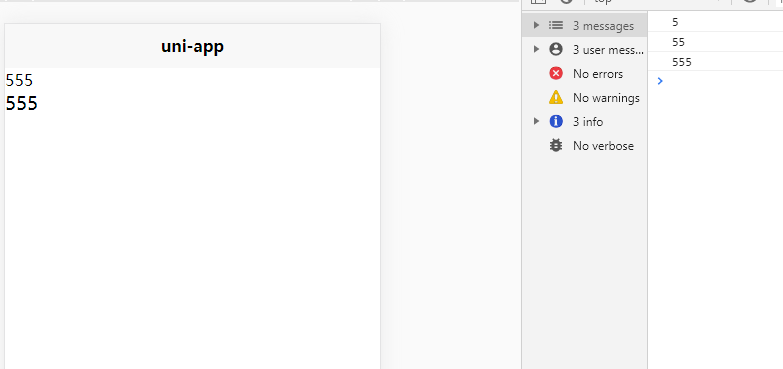uniapp - v-modal
在uniapp中,也许有人会纠结为什么会有@input还有v-model
1.它们有什么区别?
v-model:数据双向绑定->输入时绑定视图层,而@input则只是监听值
@input:监听输入的值,可以通过监听值再渲染到视图层

2. v-model用在自定义组件上
v-model的缺陷是只能在自定义组件上用一次,而这时的双向绑定就要交由.sync语法糖来解决了
1 2 3 4 5 6 7 8 9 10 11 12 13 14 15 16 17 18 19 20 21 22 23 24 25 26 27 28 29 30 31 32 33 34 35 | <template> <!-- 父组件index.vue --> <view class="content"> <onB v-model="hello" @valEvent="getValue"></onB> <input type="text" value="" v-model="hello" @input="hellos"/> {{hello}} </view></template><script> import onB from '@/components/onB.vue'; export default { data() { return { hello: '' } }, components:{ onB }, onLoad() {}, mounted() {}, methods: { hellos(e){ console.log(e.detail.value); }, getValue(e){ console.log('getValue:',e); } } }</script><style></style> |
1 2 3 4 5 6 7 8 9 10 11 12 13 14 15 16 17 18 19 20 21 22 23 24 25 26 27 28 29 30 31 32 | <template> <view @click="getValue"> <!-- onB.vue子组件 --> 子组件:{{val}} </view></template><script> export default { data() { return {} }, props: { val: String, default: '' }, model: { prop: 'val', event: 'valEvent' }, methods: { getValue(){ this.$emit('valEvent',this.val); } }, mounted() {} }</script><style></style> |
分类:
2019 - uniapp




【推荐】国内首个AI IDE,深度理解中文开发场景,立即下载体验Trae
【推荐】编程新体验,更懂你的AI,立即体验豆包MarsCode编程助手
【推荐】抖音旗下AI助手豆包,你的智能百科全书,全免费不限次数
【推荐】轻量又高性能的 SSH 工具 IShell:AI 加持,快人一步
· 10年+ .NET Coder 心语,封装的思维:从隐藏、稳定开始理解其本质意义
· .NET Core 中如何实现缓存的预热?
· 从 HTTP 原因短语缺失研究 HTTP/2 和 HTTP/3 的设计差异
· AI与.NET技术实操系列:向量存储与相似性搜索在 .NET 中的实现
· 基于Microsoft.Extensions.AI核心库实现RAG应用
· 10年+ .NET Coder 心语 ── 封装的思维:从隐藏、稳定开始理解其本质意义
· 地球OL攻略 —— 某应届生求职总结
· 提示词工程——AI应用必不可少的技术
· Open-Sora 2.0 重磅开源!
· 周边上新:园子的第一款马克杯温暖上架